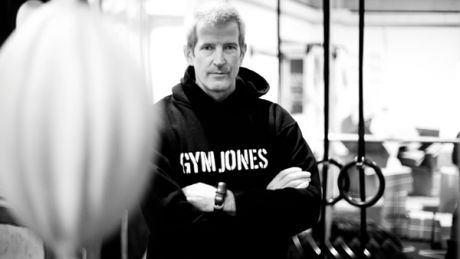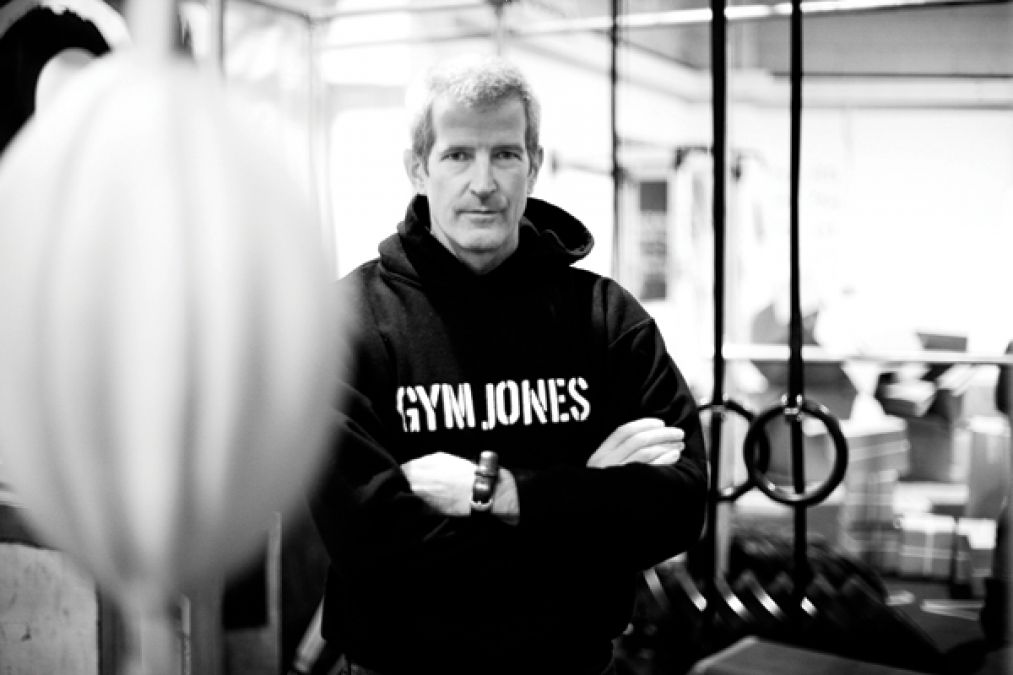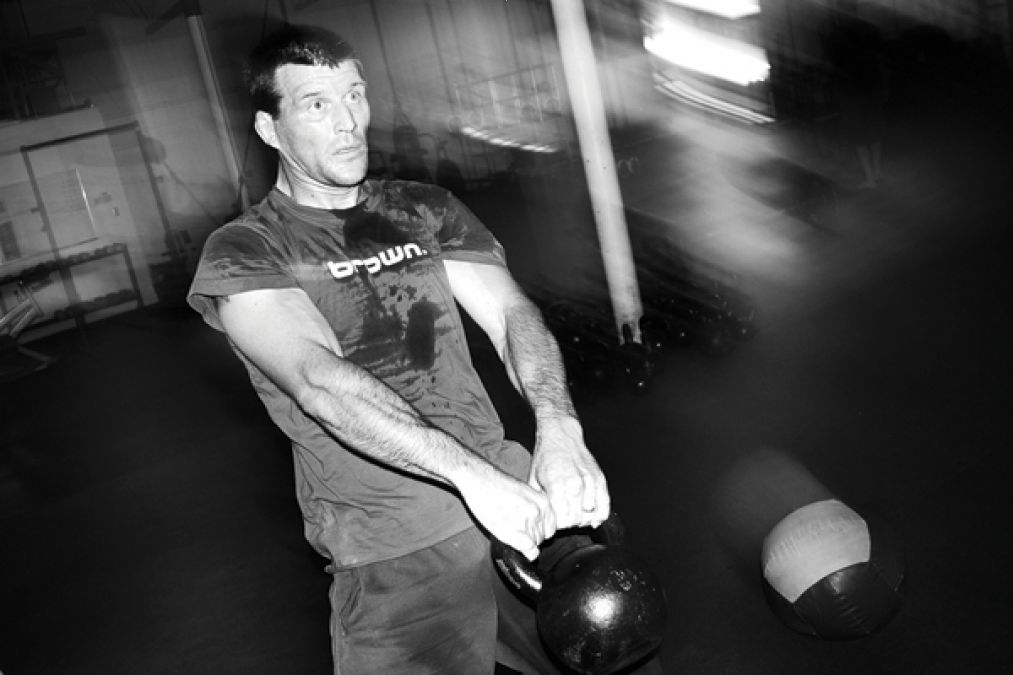The 300 Workout: Behind The Scenes At Gym Jones
We go behind the scenes at Gym Jones to speak to the creator of the 300 workout, Mark Twight


MF trains at Gym Jones - Pictures

MF trains at Gym Jones - Pictures
‘Gym Jones is not a cozy place. There are no televisions, no machines, no comfortable spots to sit and no mirrors. The training is difficult. There are no shortcuts. Physical and mental breakdowns occur.’
These words greet visitors to gymjones.com, the website dedicated to explaining the training techniques and philosophy of Mark Twight’s Salt Lake City gym. It’s an intimidating introduction, but Twight doesn’t seem to worry about that sort of thing. Formerly a world-class alpine climber, he writes in his memoir Kiss Or Kill about ‘training on an empty diet, to see how far I could push myself’.
He infamously transformed the cast of 300 from flabby actors into a sinewy army: one online video sees him explaining that anyone who turned up to train looking soft after a weekend of binge-eating ‘got smashed’. Even the Gym Jones name – chosen by Twight’s martial artist wife Lisa – is provocative, referencing the cult leader Jim Jones, who led more than 900 of his followers to drink cyanide in Guyana in 1978. One of the T-shirts worn by trainees reads, ‘There’s a fine line between salvation and drinking poison in the jungle.’
Initially Gym Jones was run more like a private members’ club, but in 2008 the doors opened and gymjones.com introduced the Salvation Club, a section of the site where anyone can get a more in-depth look at its training methods. The gym now describes itself as ‘private, but not closed’ and will allow most people inside the door, although they still run the risk of being kicked out if their work ethic or attitude doesn’t come up to scratch.
It’s also now possible to be certified as a Gym Jones trainer via a series of seminars, the first of which is the four-day Fundamentals course. I’m at the Optimal Life Fitness centre in London to attend the UK’s first. Most of the 20-odd other attendees are personal trainers and fitness professionals, but some are just interested in taking their own training to a new level.
George Mayhew, a director of corporate affairs for the National Grid, says he flew out to Utah a couple of years ago and has never looked back. ‘I’m not a fighter or an NFL player,’ says Mayhew. ‘I’m a guy who sits at a desk but finds exercise helps keep his head on straight. I’m 41 and I’m in better shape physically than I ever was in my 20s.’
Meeting Mr Jones
Although he’s got the same lean features and piercing eyes as the climber pictured in his book, when I meet him Twight is joking about London traffic and the congestion charge. He’s open, friendly and happy to talk about why his online persona is so uncompromising.
Sign up for workout ideas, training advice, reviews of the latest gear and more.
‘The psychological component is the foundation of everything we do,’ he says. ‘We like to say you become what you do, and you become who you hang around. If you’re not willing, if you’re not committed, we don’t want you because we want to control what’s going on in the gym.’
The first step to opening the gym up was to start training ‘normal’ people. Rob MacDonald, a former UFC fighter and now Gym Jones’s general manager, got the ball rolling, taking on a small group of women from an advertising agency. He had to kick a couple out of the gym before the rest took it seriously but now, MacDonald says, they train harder than many NFL players he has met.
‘I’m older now,’ Twight jokes, when asked about the gym’s new openness. ‘If we want to evolve and progress, we have to get out and teach. The problem with the closed thing is you can start to believe your own bullshit.’
Jones talk
Bullshit, it emerges as we talk through the Gym Jones philosophy, is something they don’t have much time for. In both nutrition and training, Twight and MacDonald stress the pyramid approach: get the essentials right before you worry about more complex tweaks. Don’t bother with expensive supplements until you’re eating plenty of fresh meat and veg. Don’t mess with complicated training models until you can deadlift double your own bodyweight. And in a line borrowed from one of Twight’s mentors, famed strength coach Dan John, ‘Unless you’ve eaten breakfast, don’t ask about nutrition.’
True to this idea, we start the physical side of the seminar with a basic move – the squat. To reinforce correct form, MacDonald suggests wall squats – doing the move with your toes flush against a wall, which forces you to keep your weight on your heels and drive your hips back. We finish with sets of jump squats and tuck jumps, done as explosively as possible. ‘I’ll spend as much as half an hour on this warm-up,’ says MacDonald. ‘If something’s important, you have to take the time.’
There’s no universal programme in Gym Jones but there are recurring themes. Training includes pull-up bars, gymnastic rings, Olympic lifting and almost no sit-ups (‘The only time we do sit-ups in the gym is when somebody asks for them,’ says Twight. ‘And then we give them something so awful to do they don’t ask again’).
Instead, training mostly involves heavy lifting, lung-ravaging circuits or workouts designed to tax you psychologically as well as physically. The first commandment of Gym Jones is that ‘the mind is primary’ and some workouts are harder to get through psychologically than physically. This is intentional.
‘Standing on a vibrating plate sure works, I’ve read the science,’ says Twight. ‘But it just reinforces the idea that you can get something for nothing. We like the type of training that requires you to look after yourself – where something might fall on you or you might fall on something. That will help you with your honesty.’
Running on fumes
My first taste of Jones-style ‘honesty’ is a workout called Tail Pipe. It’s a tag-team effort. One partner rows 250m while the other is the ‘rack’, holding a pair of 24kg kettlebells against their own chest. Then you switch, repeating until you’ve done the row and the rack three times each. I partner up with Ben Tye, a keen climber. ‘I’ve done this once before,’ he says. ‘It’s called Tail Pipe because when you’re finished you feel like you’re breathing exhaust fumes.’
I do the rack hold first, fixing my eyes on a spot on the wall while Tye rows his 250m in 42 seconds. We make the first changeover fast. The nasty part of Tail Pipe is that you can’t slow down too much without hurting your partner, so you hammer the row as hard as possible. This makes the second rack hold much worse than the first, and by the third you’re struggling to breathe. When I notice a couple of other attendees start to wobble, I focus on McDonald’s casual remark before we started, that ‘only one guy’s ever passed out during this’.
The last row is awful. ‘Don’t lie down,’ calls Twight as a few of us stumble off the rowers. ‘It’s just embarrassing.’ Afterwards, MacDonald explains that Tail Pipe is partly about making sure you breathe from your stomach instead of from your diaphragm, because the latter is impossible with 48kg of iron pressing against your ribcage. It’s also about pacing yourself, important in almost any sport, although rarely more often than in mixed martial arts. There’s no point rowing your first 250m in 40 seconds if the next two take 90 seconds each, just like there’s no point throwing non-stop haymakers for one round and collapsing in the second.
And, of course, if you end up going to a judges’ decision, you don’t want to send the wrong signal by lying on the floor when the fight’s over. This sort of stealth-education-via-workout is a common GJ theme.
‘I like to build workouts where people have a moment when they realise it’s harder than they thought it would be,’ says Twight. ‘Because “Did not finish” is not OK. Practice makes habit. When I practise overcoming difficult physical challenges, I get used to it. Get used to finishing.’
Prepare for glory
One of Twight’s most infamous creations is the 300 workout. The mostly British cast of Zack Snyder’s classical comic-book epic trained like any other Gym Jones athletes to transform themselves into Spartan warriors, lifting heavy and eating light to build functional muscle and strip away fat.
Andrew Pleavin, who played the leader of the Arcadians, is still a disciple and built a gym in his garage after the experience. Vincent Regan, who played the Captain, trained for three or four hours a day on 1,700 calories, lost 18kg in eight weeks and improved his deadlift from 92kg to 161kg. The videos of actors flipping tyres and dragging sleds – and the sight of their six-packs onscreen – saw Google searches for Gym Jones skyrocket.
Twight gives the impression he’d rather forget the whole experience. ‘I did my job and then it became a big thing,’ he says. ‘I look back at that and despise it because of what it led to in the virtual world. But I’m happy because of the relationships it created with some of our athletes.’
The most infamous and misunderstood part of the training was the 300 workout itself, done by selected members of the cast and stunt team as a final challenge and rite of passage. A 300-rep grind of full-body moves such as press-ups, box jumps and kettlebell swings, it has been seized on, scaled back, misinterpreted and made easier by dozens of trainers trying to board the Spartan bandwagon. Endless YouTube clips of people doing the workout with bad form or different moves – or ‘on a fucking Smith machine’, Twight recalls – prompted GJ to invent a simpler, impossible-to-cheat version known as 300 FY: ten minutes on an Airdyne bike or rowing machine. If you clock up 300 calories on the monitor in that time, you’ve done the workout. If you don’t? That’s what the FY stands for.
Crossing over
Of course, if there’s one philosophy the casual onlooker might expect Gym Jones to identify with, it’s that of CrossFit, the online workout site whose workouts of the day get thousands of hits a month. Both regimes prescribe a similar blend of gymnastics and weightlifting, both emphasise intensity and both are a hit among athletes in ‘extreme’ sports such as MMA.
Twight, in fact, did CrossFit workouts for a couple of years. Now, though, he thinks the approach has its failings. ‘I had a relationship with [CrossFit founder] Greg Glassman back in 2004 and he made a lot of promises of CrossFit,’ he explains. ‘To use a fishing metaphor, he threw the bait in the water, I took it, chewed it and swallowed it. But finally it came out the back. And that’s when I cut the string and said, “There are great ideas here, but it’s not working for what I want to do.”
‘When you’re training athletes at a certain level, general fitness is no longer functional and we have to become specialised. There’s a reason why guys who run the 100m don’t also run the mile.’
Where CrossFit can be accused of following a one-size-fits-all philosophy, individualised, structured training is a Gym Jones hallmark and teaching students to write their own programmes is a fundamental part of its training. ‘My goal is that in a year, people should be fully capable of training somebody else,’ says MacDonald.
True grit
This is the biggest surprise. Behind the attitude, the swearing, the black-and-white photos of people gritting their teeth in pain and workouts such as the Vomit Comet (three rounds of sandbag presses, pull-ups, burpees and kettlebell swings), there’s an outlook suitable for anyone.
It’s a training programme that doesn’t promise miraculous results, just ones proportional to the amount of work you put in. The only people Gym Jones has no time for are those who expect fast results without hard work.
‘I’ve got no problem with somebody who says, “I don’t care enough about the way I look to make that sort of commitment,”’ says McDonald. ‘I will shake that person’s hand. What I can’t stand is people who say, “Oh, I haven’t got the time,” or “It’s too hard.” No. Just admit that you don’t care enough.’
This is the new Gym Jones. It’s certainly elitist, but it isn’t just for the elite. The roster includes champions in Brazilian jiu jitsu, high-level climbers and star cyclists, but it also has regular people. What connects everyone is a willingness to do what they have to, to get the results they want. Your 5K row time isn’t as important as your commitment to improving it. Or, as Twight puts it, ‘This is for the rest of your life. If you need results in two weeks, you should have started three months ago.’
I get one final illustration of this ethos during one of the last workouts of the seminar. Jonescrawl is fairly simple: ten deadlifts with 115% of your bodyweight, then 25 jumps on to a 60cm box – three rounds as fast as possible. I rocket through the first set of deadlifts, but slow down hugely on the box jumps. By the second and third rounds, I’m sucking air and having to psych myself up for every leap, fearful of scraping my shins and upending myself.
Twight, who’s timing me, patiently coaches me through it, urging me to keep going without the drill-sergeant shouting that’s the hallmark of most tough trainers.
I finish in a disappointing 6min 47sec, nearly double the time of the fastest man in the group, but I’ve gone as hard as I can and finish with nothing left in the tank. It seems to be enough for Twight. ‘Nice fight,’ he says, smiling. I don’t lie down.
Making the grade
Gym Jones considers these tough moves to be their ‘adequacies,’ and should be reached by anyone who trains there. How many can you do?
Deadlift 2 x bodyweight One of the most fundamental exercises for strength in any sport. Standing sumo-style is not accepted.
Front squat 1.5 x bodyweight ‘We prefer this to the back squat because it encourages good form,’ says MacDonald. Find a form guide here.
Overhead squat 1 x bodyweight ‘A fundamental move that tests your flexibility and core strength,’ says MacDonald. Start with the bar racked or snatch it.
Bench press 1 x bodyweight One of the easiest standards for most gym-goers to hit. ‘If you want a challenge, try five reps of one-arm bench press with a 32kg kettlebell,’ says Twight.
Pull-up x25 Leg movement, or ‘kipping’, is fine but range-of-motion requirements are strict: straight arms at the bottom, whole head over the bar at the top.
Kettlebell snatch 150 in 10min You can switch hands or put the kettlebell down as necessary. MacDonald’s ad girls can manage 200 with a 12kg bell – you should use a 24kg model.
Row 500m in 1min 30sec Good news if you’re a lightweight, defined by Gym Jones as under 75kg – your slighter stature buys you an extra three seconds.
Some Gym Jones workouts
Feeling fit? Then have a crack at these tough Gym Jones workouts
Tag Team This describes any effort done as a team. Pick one move with a fixed number of reps or distance and one ‘hold’, such as the Tail Pipe, or a 400m run and hang from a pull-up bar.
30/30s Do as many reps as possible for 30 seconds, then rest in a stressed position for 30 – try press-ups/planks, chin-ups/dead hangs or squats/squat holds. Do four rounds.
Breathing Ladder Pick a big move, such as a kettlebell swing or dumbbell thruster. Do a rep, then take a breath, two reps, take two breaths and carry on to 20. You will end up ‘panic breathing’.
SMMF The Single-Movement Mind-Fuck is one move done an unreasonable number of times, such as 1,000 lunges, which you’d do over a couple of hours. Pick a good soundtrack.
From 2008 to 2018, Joel worked for Men's Fitness, which predated, and then shared a website with, Coach. Though he spent years running the hills of Bath, he’s since ditched his trainers for a succession of Converse high-tops, since they’re better suited to his love of pulling vans, lifting cars, and hefting logs in a succession of strongman competitions.

